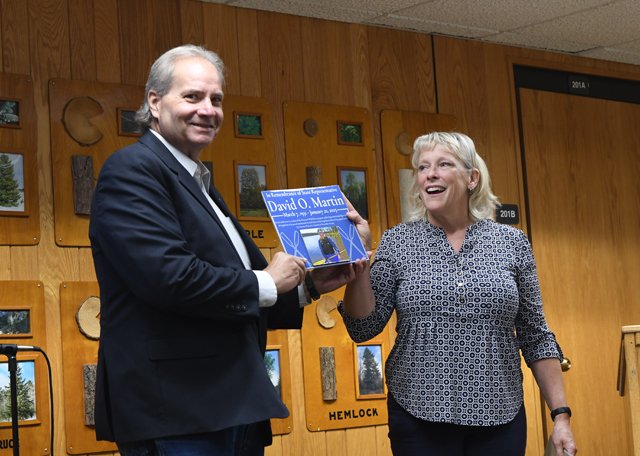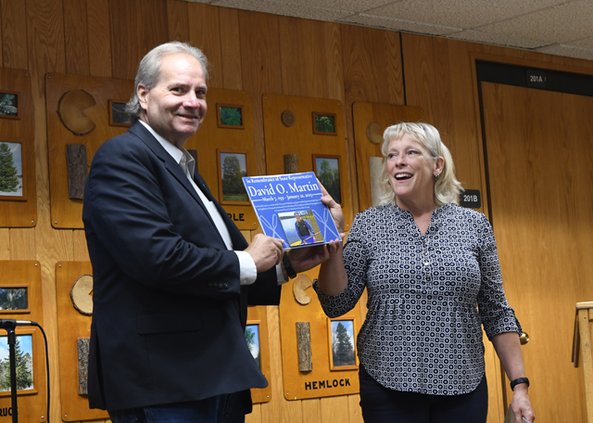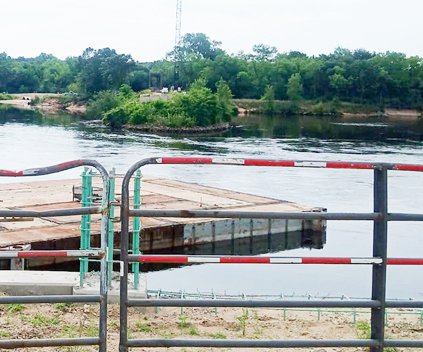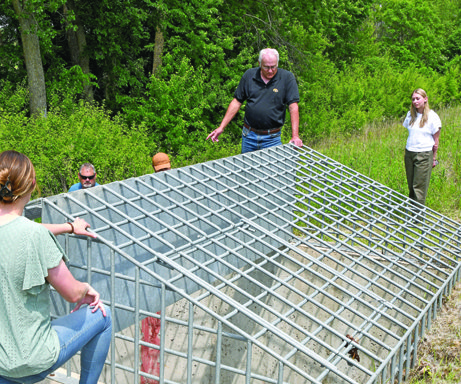Just shy of his 94th birthday, Dave Martin, author of Wisconsin’s Wild Rivers Law, passed away in January of 2025. The bipartisan law he spearheaded unanimously through both houses of the Wisconsin Legislature in 1965 is now 60 years old.
“Dave Martin spoke at the 40th anniversary of the Wild Rivers Law, and then at the 50th I was here,” Lower Wisconsin State Riverway Board (LWSRB) executive director Mark Cupp said. “As recently as last October, he planned to be here for this event as well.”
Martin was not able to be physically present in Florence at the celebration of the Law’s 60th anniversary at the Wild Rivers Interpretive Center (WRIC) on Saturday, June 28. But there is no question he was there in spirit, living on in the memories of those who knew him and in the legacy of the wild rivers that are protected in Wisconsin.
The rivers protected by the law authored by Martin include the three original rivers - the Pike, Pine and Popple rivers. Since then, a portion of the Brunsweiler River in Ashland County, and the Totagatic River that runs through Bayfield, Sawyer, Washburn, Douglas and Burnett counties have been included under the law’s protections.
“For those who didn't know Dave, he was from the Neenah-Menasha area,” Cupp explained. “He went on to UW-Madison, but he actually graduated from the University of Michigan with a degree in forestry. After graduation, he went to work for Kimberly Clark.”
Cupp told the story of how Martin was working as a forester, and was in the Upper Peninsula of Michigan, in an area with beautiful old growth forest.
“He just hated to see all of those beautiful trees being cut down, and so he went to his supervisor and said, “can't we just save 40 acres?” Cupp remembered. “Forty acres - just for posterity, for the future?”
According to Cupp, his supervisor said, “no, we are not in the business of saving old growth forest. We're in the business of cutting down trees for timber production.”
“Well, he was young and naive, so he went over his supervisor’s head. Obviously that didn't go over well, and the trees got cut down, and Dave had a black mark on his record,” Cupp said. “You knew where his heart was right from that point forward.”
Martin then served during the Korean conflict in Germany with the U.S. Army Corps of Engineers. While there, he was building temporary bridges and rebuilding bridges throughout war torn Europe. And then after he did his term of service, he came back to Kimberly Clark and started working more in the government affairs area.
“Dave decided to run for the Wisconsin State Assembly as a Republican in 1960, and served five terms. The Wild Rivers Law was one of his signature pieces of legislation,” Cupp recounted.
After retirement, Martin moved to a property along the Lower Wisconsin River. Even in retirement, Martin kept active, running a café in Marquette, Iowa. According to Cupp, the café was a labor of love for Martin and his wife. Though the business never made a lot of money, Martin kept doing it for the people that patronized his café, where prices were affordable and the atmosphere was welcoming.
“That was kind of man Dave was. He also continued to work so diligently on those things that he believed in, the kind of things that were predominant in Wisconsin - clean government, fair elections, and campaign finance reform,” Cupp told the group. “He did not believe in this concept of gerrymandering at all. He believed that politics should be determined in the marketplace of ideas, and he fought for that all the way to the end.”
Cupp noted that Martin also served two terms on the Riverway Board.
“When his close friend Frank Shadewald died, he assumed a leadership role in the Three Eagles Foundation which oversees the Frank’s Hill effigy mound site, and we served on that board together to protect this very special sacred site in Richland County,” Cupp said. “He served until he died, and he also supported the River Alliance of Wisconsin and many other conservation oriented groups. He heartily supported Southwest Technical College, and remained engaged in politics up until last November's election at both the local, state and federal levels.”
Cupp said that Martin loved to look out his window on the Wisconsin River, and report to him regularly about the fauna and flora that came and went through the seasons.
“It was his own phenology calendar, except he was just sharing it with others,” Cupp remembered.”
In closing, Cupp quoted from ‘Silent Spring’ author Rachel Carson to summarize Martin’s life and accomplishments.
“Conservation is a cause that has no end. There is no point at which we will say our work is finished.”
“We have to continue to support the Wild Rivers Interpretive Center, the River Alliance of Wisconsin, the Riverway Board, and all these other land trusts and non-profits that are out there, because the work is never done,” Cupp said. “There are always new challenges. We have the two additional wild rivers that are out there now, and there are probably other candidates for the future, but they all need leadership. They need staff. They need money. We need the Knowles-Nelson Stewardship Fund to help support those groups and land trusts - the work is never done.”
Allison Werner
River Alliance of Wisconsin executive director, Allison Werner, was the next person to share some memories of Dave Martin.
“I'm fortunate that the colleagues that preceded me at the River Alliance of Wisconsin did a great job with our archives,” Werner said. “At those 40th and 50th anniversaries of the law, we collected some stories, including some articles that Dave wrote himself. So I'm going to be able to share his own words with you today.”
Werner said that while Martin is best remembered for his wild rivers leadership, there was an earlier act of legislation that he played a part in.
“Now let me tell you about the Wolf River Protection bill of 1963,” Werner said. “In 1963, he received a call from another northern river protection pioneer, the late Herb Bittner. Herb relayed to Dave that a dam had been proposed on the Wolf River near Pearson. The idea was to create a lake and sell lots along its shoreline.”
Werner said that wildlife and sportsman's groups shared Martin and Bittner's concerns that during low water time, the dam would have reduced the Wolf River to a trickle downstream, and would have drastically changed the character of that beautiful river.
“So, as Dave often did, he got to work drafting a bill. Time was of the essence in moving this legislation forward, and Dave said that there were a lot of attempts to block it,” Werner relayed. “In fact, Langlade County had already built concrete abutments on both sides of the river at the dam site. After lots of negotiations, the bill passed and the dam was never built. In 1968 the 24-mile segment from Langlade to the Menomonee County line, downstream of Keshena Falls, was designated as a federal Wild and Scenic River.”
Werner said that Martin’s work to protect the Wolf River was only one of the inspirations for his effort to create the Wild Rivers Act. She said that we are also fortunate to have his own reflections on his adventures on the Pine River.
In Martin’s own words:
“The most memorable time I've ever spent on a northern river was on the South Branch of the Pine River in 1966, right about the time when the Pine was being designated as a Wisconsin wild river. A friend and I put in at Jones Dam and floated downstream in a duck skiff to the cabin that my dad and brother had built. Along the way, we stopped to camp at what was referred to as ‘Wild Cat Rapids.’ The trip made such an impression on me because it was a trip of firsts - the first time I was introduced to what would be characterized as a truly wild area, the first time I saw Woodcock and heard its distinctive whistle, and my first introduction to the boldness of ravens and the camp robber tactics of the Canada Jay. I never had an experience like this before. And to this day, I don't believe most people have ever had this sort of experience. I remember so well that there was so little noise other than the natural sounds of our surroundings, there weren't telephones. It was quiet. I've learned alot about myself and the natural environment through spending time on the Pine River. There's no doubt that of all the experiences I've had on the Pine River over the past 40 or more years certainly gave me the motivation, energy and drive to work hard on protective environmental legislation while I was in the Assembly. Those experiences on the Pine gave meaning to my work, and still do.”
Other speakers
Wendy Gehlhoff, education and promotions director with the Interpretive Center, gave an overview of all the recreational opportunities available on Wisconsin’s wild rivers, and the efforts made to let the public know what’s available.
“The Secretary of the DNR and Secretary of Tourism helped us design our wild river signs. There's actually a 100-mile loop that goes all the way through Florence County, and we have brochures where a lot of the access points to the rivers are marked,” Gehlhoff explained. “On the back you'll see the sign numbers, and it tells you about each of those different access points. So some are for waterfalls, some are for hiking. You can fish, you can pick berries - there's so many different things you can do on the river. We've got all the waterfalls marked, as well as campgrounds and boat landings, and everything else.”
Chris Jennings of the Wisconsin Department of Tourism, working as a tourism development specialist in the state’s 27 northern counties, spoke next.
“Wisconsin tourism is on a roll from across the state to here in Florence County,” Jennings said. “Outdoor spaces like the wild rivers are a big reason why. Earlier this month, the Wisconsin Department of Tourism released our 2024 economic impact data. Last year, Wisconsin tourism generated a record-breaking $25.8 billion in economic impact.”
“And for our local success, we need look no further than the wild rivers legislation. Among the intentions of this legislation was, and I quote, “to afford the people of this state an opportunity to enjoy natural streams, to attract out-of-state visitors, and assure the well being of our tourist industry.” Sixty years later, I can say with conviction that we have succeeded in this goal, and countless hikers, hunters, anglers, trappers, campers and paddlers have traveled to experience these truly wild and free flowing rivers.”
State Senator Mary Felzkowski and Representative Jeffrey Mursau presented the Interpretive Center with a citation from the State Legislature marking the 60-year anniversary.
Trout Unlimited’s Great Lakes Program Manager Chris Collier gave an overview of the restoration work his team has undertaken on the wild rivers and across the northern Great Lakes Region. In particular, he emphasized his organization’s success in partnering with local municipalities, helping to address infrastructure issues while promoting fish passage.
Last up was John Roberts, a Florence County paddling enthusiast and Interpretive Center volunteer. Roberts gave a moving recitation of a wilderness essay he’d written, sharing his experience on a wild river.









